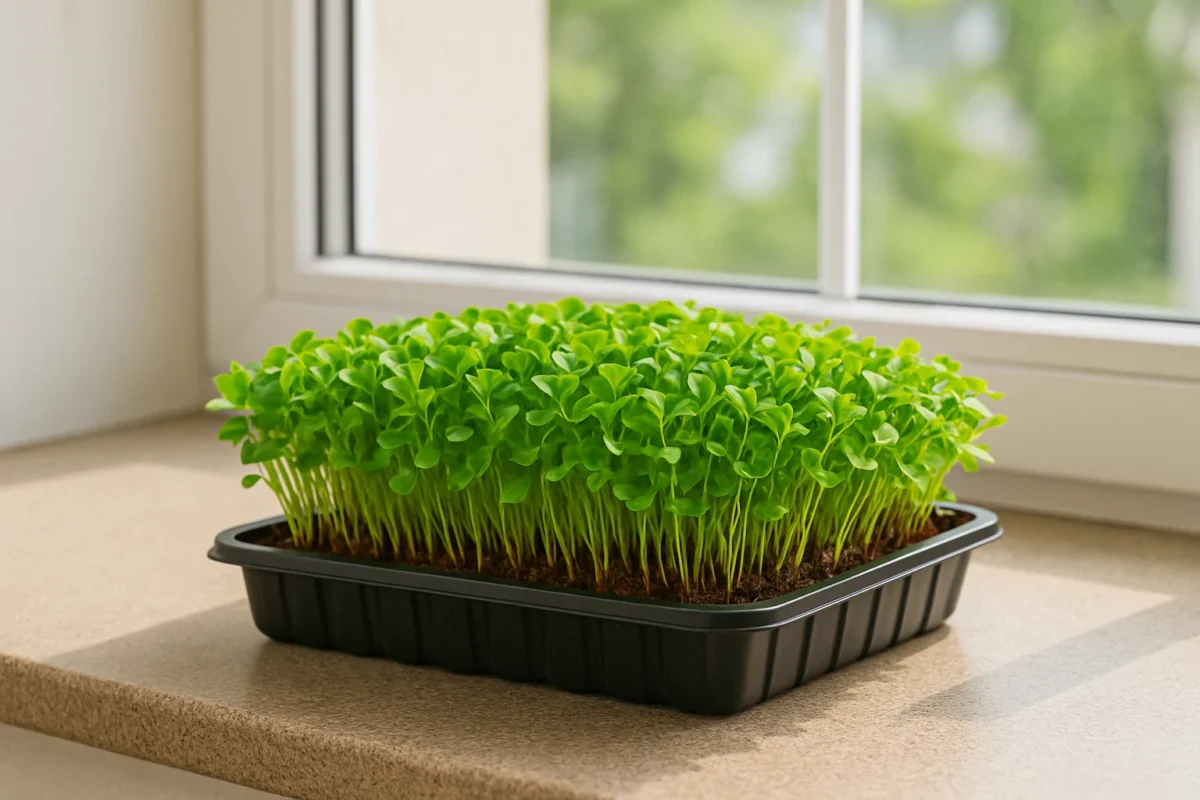Microgreens are tiny, flavour-packed greens that you can grow indoors all year round—no garden required. If you’re wondering how to grow microgreens successfully, whether you’re a health-conscious foodie, a parent looking for a fun project with kids, or someone with limited space, microgreens are the perfect way to cultivate fresh, nutritious greens right on your windowsill or kitchen counter.

What Are Microgreens?
Microgreens are the young seedlings of edible vegetables and herbs harvested just after they sprout. If you’re learning how to grow microgreens, it’s important to know they differ from sprouts because they grow in soil or a growing medium and are harvested above the root. Packed with nutrients, these greens come in a wide variety of flavours, textures, and colours.
Popular Types of Microgreens to Grow at Home
- • Radish: Peppery flavour and fast-growing (5–7 days)
- • Broccoli: Mild, crunchy, very nutritious
- • Pea shoots: Sweet and tender, ready in about 10–12 days
- • Sunflower: Nutty flavour, good bite, ready in 7–10 days

Why Microgreens Are Perfect for Home Growing
Microgreens are ideal for beginners learning how to grow microgreens at home. They’re fast-growing, don’t require special equipment, and can be cultivated in small spaces with minimal effort. Plus, they make a rewarding project for kids and families alike.
Benefits of Growing Microgreens Indoors
- • No need for outdoor space or garden beds
- • Grow year-round regardless of the weather
- • Quick turnaround (most are ready in under 10 days)
- • Visibly rewarding — you’ll see daily progress
- • Highly nutritious — often more concentrated than mature plants
What You’ll Need to Start
Here’s what you need to get started growing microgreens at home.
Basic Equipment Checklist
- • Microgreen seeds (e.g. radish, broccoli, sunflower, pea shoots)
- • Growing trays (shallow trays with and without drainage holes)
- • Growing medium (e.g. coco coir or soil mix)
- • Spray bottle (for misting during germination)
- • Grow lights (optional but helpful for consistent results)
- • Cover tray or blackout dome (for initial germination)

Step-by-Step Guide to Growing Microgreens at Home
If you’re wondering how to grow microgreens, here’s a beginner-friendly process you can follow from seed to harvest:
Step 1 – Prepare the Growing Tray
- Place your tray without holes inside a tray with holes (for drainage).
- Fill the top tray with 1.5–2cm of moistened coco coir or soil.
- Level the surface gently using your hand or a clean scraper.
Step 2 – Measure and Sow the Seeds
- Sprinkle seeds evenly across the surface. Use:
- Radish: ~10g per tray
- Broccoli: ~6g per tray
- Pea shoots: ~25g per tray (pre-soaked)
- Sunflower: ~30g per tray (pre-soaked)
- Gently press them down into the medium — don’t bury them.
Step 3 – Mist and Cover for Germination
- Spray the seeds generously with a spray bottle.
- Cover with an empty tray (or dome) to create darkness and retain moisture.
- Store in a warm place (ideally 20–22°C). Wardrobes or cupboards work well.
Step 4 – Check Daily and Keep Moist
- • Open the tray once a day to check moisture.
- • Mist if surface is drying out.
- • Germination takes 2–4 days depending on the variety.
Introducing Light After Germination
Once the seeds have sprouted and developed small roots and stems:
Step 5 – Move to Light
- • Uncover and place trays under a grow light or by a sunny window.
- • Keep lights on for ~12–16 hours per day.
- • Keep watering from below by pouring water into the bottom tray (avoid top misting now).

When and How to Harvest
When learning how to grow microgreens, you’ll find they’re usually ready to harvest when they’re about 5–10 cm tall and have developed their first true leaves.
Step 6 – Harvest Time
- • Cut just above the medium with clean scissors.
- • Harvest all at once or as needed.
Storage Tips
- • Store in an airtight container in the fridge.
- • Best eaten fresh but can last up to 5–7 days when dry.
Frequently Asked Questions (FAQs)
Do I need to soak all seeds?
- • Yes for sunflower and pea shoots (8–12 hrs).
- • No for radish and broccoli — sow dry.
Can I reuse the growing medium?
For anyone figuring out how to grow microgreens, it’s best to compost and use fresh growing medium each time to avoid mould and disease.
Can kids do this project?
Absolutely! It’s a great way to teach them about growing food, responsibility, and nature.
Final Thoughts – Why You Should Start Growing Microgreens Today
Microgreens are one of the easiest and most rewarding ways to learn how to grow microgreens and produce your own food at home. You don’t need a garden, fancy tools, or loads of time. In under two weeks, you’ll have fresh greens full of flavour and nutrients—perfect for salads, sandwiches, and garnishes. Start simple with radish or broccoli, involve your kids, and enjoy the satisfaction of growing your own food—even in a small space.
Sources
